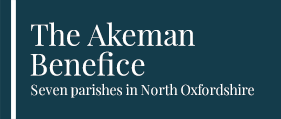St Giles’, Bletchingdon – our history
Although the precise date of the first church on this site is not known, the present building is believed to date from the eleventh century and has traces of Norman architecture still visible, including a Norman lintel on the south wall. The Early English Gothic chancel was built in the thirteenth century.
There have been many additions and changes over the years, including the addition of the nave in the fifteenth century and the south porch with a four-centred arch in 1695. Charles Buckeridge designed the north aisle, which was added in about 1869. The church was heavily restored to Buckeridge’s designs in 1878.
Among the treasures inside the church are a fragment of a fifteenth-century wall painting in the chancel, a Jacobean pulpit and pews, a seventeenth-century painting, a font which has been in use since 1682, and many beautiful memorials to the occupants of Bletchingdon Park. As a young man, Christopher Wren lived at The Rectory with his family after his father was deprived of his living by the Puritans, his sister having married the then Rector, William Holder. Dean Wren is recorded in the burial register for 1656 and is believed to be buried under the chancel floor.
The west tower has a ring of six bells. Robert and William Cor of Aldbourne, Wiltshire, cast the tenor bell in 1710. Edward Hemins of Bicester cast the second bell in 1738. Matthew III Bagley of Chacombe, Northamptonshire, cast the fifth bell in 1774. James Barwell of Birmingham cast the third and fourth bells in 1877, along with a Sanctus bell. The Whitechapel Bell Foundry cast the treble bell in 1998.
In 2000 the church was updated and modernised, including a new stone floor, making the church accessible for wheelchairs. New heating and lighting, a pantry, and a lavatory were installed. A car park was also added.
St Giles’ is a Grade 2* listed building



